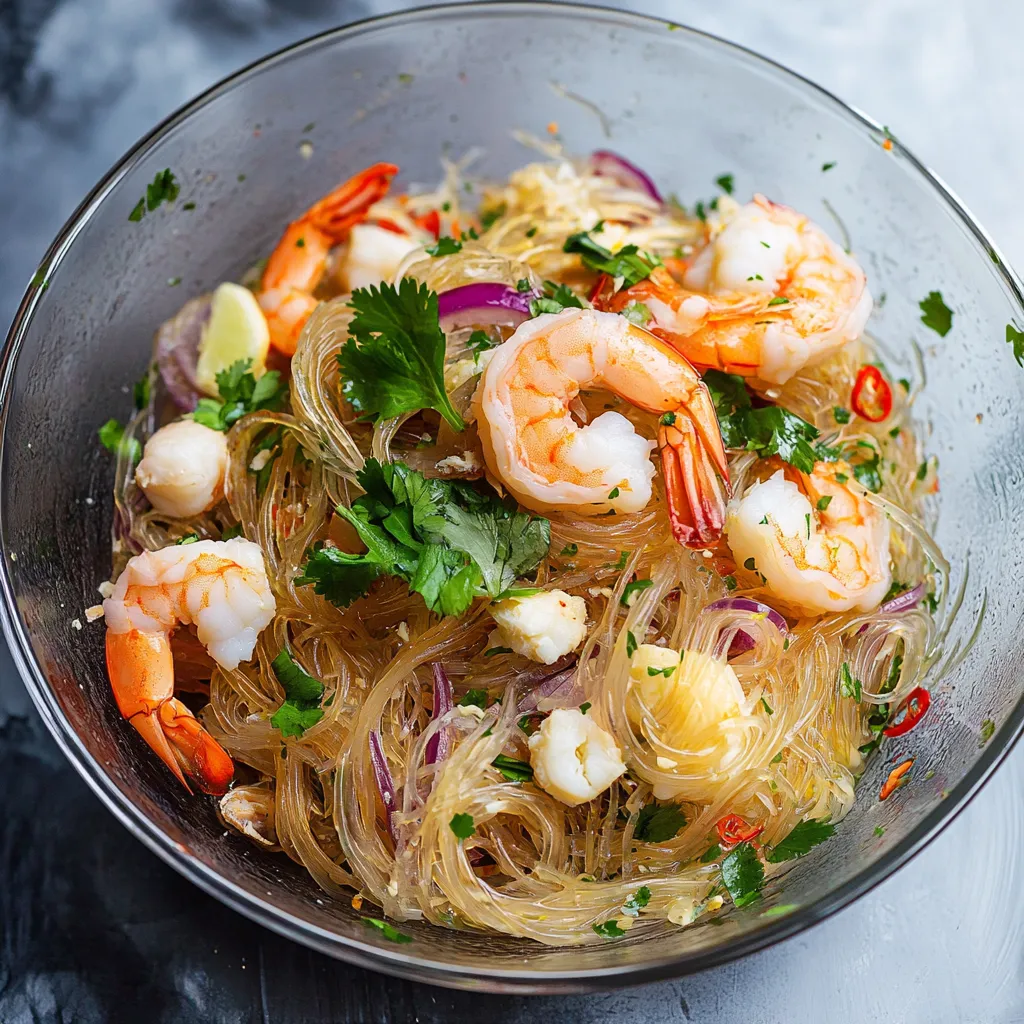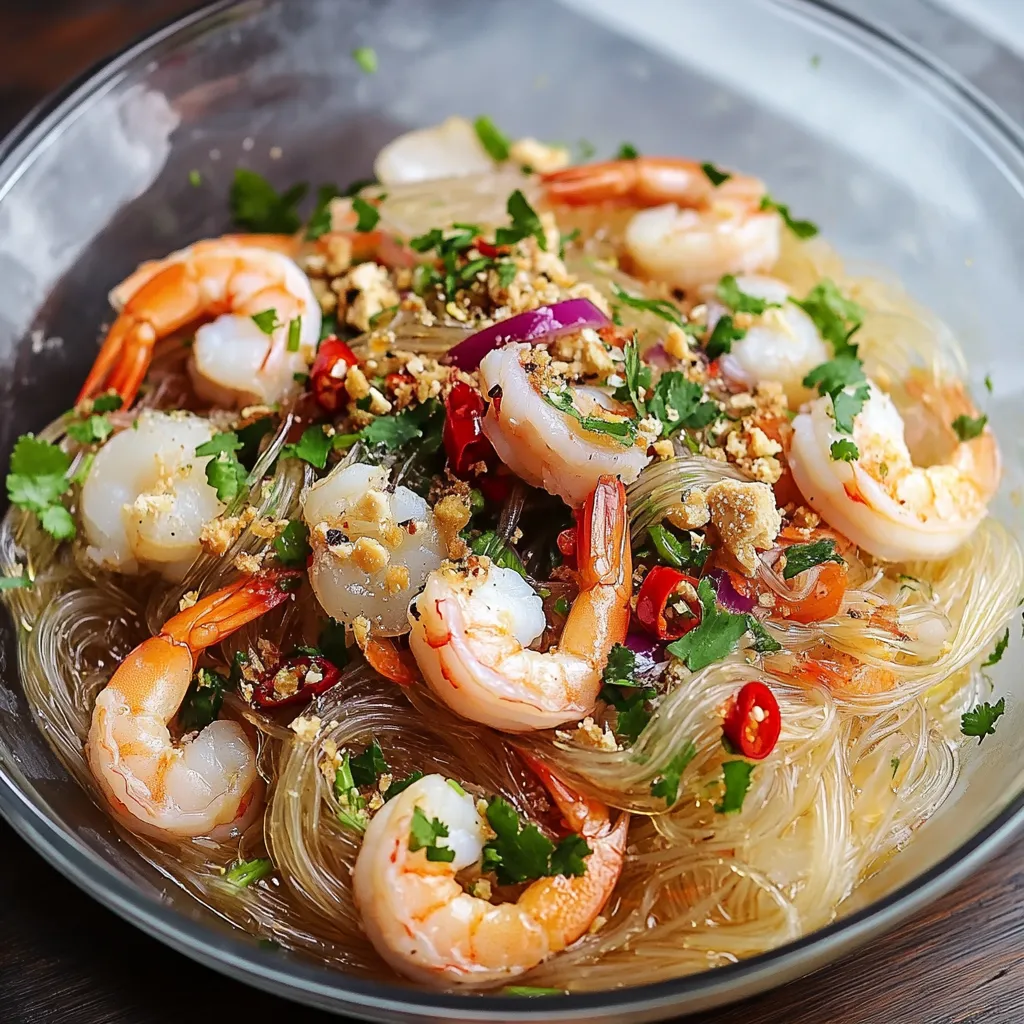 Pin it
Pin it
Yum Woon Sen delivers an explosion of authentic Thai flavors in every bite, combining delicate glass noodles with savory proteins and fresh vegetables. The transparent noodles absorb the complex sauce beautifully, creating a perfect vehicle for the harmonious blend of salty, sweet, spicy and sour elements that define Thai cuisine. Unlike heavy pasta dishes, this vibrant salad feels refreshingly light while still providing satisfying textures and deeply developed flavors. Each forkful reveals different elements of the dish as the aromatic herbs and punchy sauce coat the slippery noodles and tender proteins, making every bite a new discovery of taste and texture.
I first encountered Yum Woon Sen during a cooking class in Chiang Mai, where our instructor emphasized that the true artistry lies in achieving perfect flavor balance. Back home, I recreated the dish during a summer heatwave and was amazed at how refreshing yet satisfying it felt as a complete meal. My family initially approached it cautiously, unfamiliar with glass noodles, but after their first taste, they were immediately converted. Now it features regularly in our meal rotation, especially during warmer months when we crave something light yet flavorful.
Special Ingredients
- Glass noodles: These transparent, slippery noodles offer a unique texture unlike any other pasta and absorb flavors beautifully without becoming mushy.
- Fish sauce: Provides the essential umami foundation that gives authentic Thai dishes their distinctive savory depth.
- Fresh lime juice: Contributes bright acidity that activates your taste buds and balances the richness of other ingredients.
- Palm sugar: Offers a more complex sweetness than regular sugar with subtle caramel notes that harmonize with spicy elements.
- Thai bird's eye chilies: Deliver clean, sharp heat that builds gradually without overwhelming the other flavors.
- Fresh herbs: Cilantro, mint and green onions add aromatic freshness that elevates the entire dish and provides color contrast.
- Dried shrimp: These tiny flavor bombs contribute concentrated seafood essence and interesting textural elements throughout the salad.
- Toasted peanuts: Provide essential crunchiness that contrasts beautifully with the soft noodles and tender proteins.
Cooking Instructions
- Noodle Preparation:
- Begin by placing your glass noodles in a large heat proof bowl. Bring water to a rolling boil, then pour it directly over the noodles. Allow them to soak for approximately 6 minutes until they become pliable but still retain some firmness. Unlike wheat pasta, glass noodles continue softening after draining, so slightly undercooked is preferable to overcooked. Once they reach the proper texture, immediately drain and rinse under cold running water to halt the cooking process and remove excess starch.
- Protein Cooking:
- Fill a shallow wide pan with approximately two inches of water and bring to a gentle simmer. Add a tablespoon of fish sauce directly to this cooking liquid to infuse your proteins with flavor from the start. Carefully add your chosen proteins to the simmering liquid, keeping seafood items separate from ground meats if using both. Poach gently until just cooked through, typically 2 minutes for shrimp and 3 minutes for ground chicken or pork. The gentle poaching method preserves tenderness while allowing the proteins to absorb the seasoned cooking liquid.
 Pin it
Pin it
The first time I prepared this dish for Thai friends, I worried whether my version would measure up to their expectations. Instead of criticism, I received the highest compliment when they told me it reminded them of home. What makes Yum Woon Sen special to me is how it demonstrates the Thai culinary philosophy of balance. My grandmother always taught me that great cooking isn't about following exact measurements but understanding how flavors interact. This dish exemplifies that wisdom perfectly, allowing each cook to adjust components while maintaining the essential character that makes it authentically Thai.
Perfect Pairings
Yum Woon Sen works beautifully alongside other Thai dishes for a complete meal experience. Serve it with satay skewers and peanut dipping sauce for a perfect protein complement that enhances the nutty elements already present in the salad. For a refreshing beverage pairing, Thai iced tea provides sweet creaminess that counterbalances the salad's tanginess, or try a cucumber limeade for something non alcoholic that echoes the fresh, bright notes in the dish. If serving as part of a larger Thai feast, include a coconut based curry to provide rich, warm flavors that contrast with the cool, zingy salad.
 Pin it
Pin it
Creating Yum Woon Sen in my kitchen always transports me back to that small cooking school in Thailand where I first learned to appreciate the complexity behind seemingly simple dishes. There's something deeply satisfying about watching someone taste it for the first time and seeing their expression transform as they discover how light noodles can deliver such bold flavors. Though the ingredient list might seem intimidating initially, mastering this dish opens the door to understanding Thai cuisine's fundamental principles. The beauty of Yum Woon Sen lies in its adaptability while maintaining its essential character, making it both an authentic cultural experience and a practical addition to any home cook's repertoire.
Frequently Asked Questions
- → Can I substitute the proteins in this Thai Glass Noodle Salad?
- Absolutely! While traditional Yum Woon Sen uses chicken and seafood, you can substitute with tofu, mushrooms, or other seafood like crab meat. Just adjust cooking times accordingly since different proteins require different cooking durations.
- → Where can I find glass noodles?
- Glass noodles (also called cellophane noodles or bean thread noodles) are available in the Asian food section of most supermarkets, Asian grocery stores, or online. They're typically made from mung bean starch and come in dried form in small bundles.
- → How spicy is this Thai Glass Noodle Salad?
- The spice level is adjustable based on how many Thai bird's eye chilies you use. For mild heat, use just one chili or remove the seeds. For authentic Thai spiciness, use 2-3 chilies with seeds intact. You can always serve additional sliced chilies on the side.
- → Can I make this Thai Glass Noodle Salad ahead of time?
- While best served fresh, you can prepare components separately up to a day ahead. Cook the proteins and noodles, make the sauce, and slice the vegetables, then store separately in the refrigerator. Combine everything just before serving and allow to come to room temperature for best flavor.
- → What can I substitute for palm sugar?
- If you can't find palm sugar, brown sugar or honey make good substitutes, though they'll change the flavor profile slightly. Start with slightly less than the recipe calls for, then adjust to taste, as these alternatives can be sweeter than traditional palm sugar.
- → Is fish sauce essential for authentic Thai Glass Noodle Salad?
- Fish sauce provides the distinctive umami foundation for this dish. If you need to substitute, try using soy sauce mixed with a pinch of salt, though the flavor won't be exactly the same. For a more authentic alternative, look for vegetarian fish sauce made from seaweed at specialty stores.
